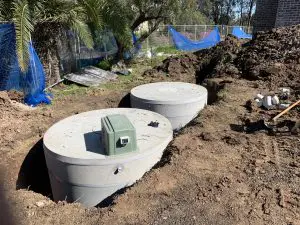How do aerated wastewater treatment systems work
Aerated wastewater treatment systems work mostly aerobically (in the presence of oxygen) to promote the microbiological consumption of organic matter. Over some time, microbes respire and during this process, the organic matter is broken down.
Stage One – Primary Chamber
To begin the process of wastewater treatment is introduced into a ‘primary chamber’. In this chamber, the sludge can settle in the bottom, and scum in the form of grease and oils forms on top of the wastewater. Anaerobic digestion (in the absence of oxygen) takes place in the primary chamber to separate the solids from the scum.
Stage Two- Aeration Chamber
 In the aeration chamber, oxygen is supplied and mechanical mixing of the waste product takes place. This process encourages bacteria to convert organic nitrogen and ammonia to nitrates. It can also be done passively (without mechanical mixing) by pouring the waste over a porous material.
In the aeration chamber, oxygen is supplied and mechanical mixing of the waste product takes place. This process encourages bacteria to convert organic nitrogen and ammonia to nitrates. It can also be done passively (without mechanical mixing) by pouring the waste over a porous material.
The size of the mixing chamber will need to be tailored to the amount of waste they will process as this will ensure endogenous respiration. The chambers will need to be cleaned periodically as residue collects. Inspection of the chamber should be part of the maintenance schedule.
The process is also affected by differences in organic and hydraulic loads. Low or inconsistent load types have been known to be detrimental to the overall performance of waste processing. The running of aerated wastewater systems requires hands-on monitoring and adjustment of air supply and sludge return to ensure optimal performance of the system.
Some important factors to monitor are the speed, volume, and timing of air supply, and the ratio of microorganisms to food. Variation in atmospheric temperature, pH levels, age of the waste and the ratio of sludge return will speed up or slow down the rate of bacterial activity.
Stage Three – Clarification Chamber
The next stage is allowing the treated water and solids to naturally separate by a process known as clarification. By providing still conditions, the heavier, solid elements will sink separating from the water over time.
The clarification chamber often has a funnel-shaped bottom designed to minimise re-suspension by concentrating the settled solids. These concentrated solids can then be reintroduced into the aeration chamber or pumped out of the system altogether.
Stage Four – Disinfection Chamber
The treated wastewater must then be disinfected. This occurs in the disinfection chamber. During this process, any organisms present that may cause diseases are removed using either a chemical intervention such as chlorine or UV (ultraviolet) irradiation. Chlorine is the typical method of disinfection. UV treatment, though less common, is beginning to gain acceptance as research grows. UV treatment would have advantages over chlorine as chlorine is corrosive to metal parts of the wastewater treatment system.
Stage Five – Desludging
The final step of the process within an aerated treated wastewater treatment systems is desludging. Sludge accumulation in the tanks should be inspected as part of a maintenance schedule and then the sludge should be removed leaving 10% to leave enough bacterial population. Sludge removal should be carried out by a licensed contractor.
For more information contact us today and book a service call. You can call us on 1800 808 135 and speak to one of our friendly members of the service team.
We’re a certified covid safe company here to offer you peace of mind and top quality service.
Related Posts
- Design and Sizing Considerations for Home Sewage Treatment Systems
- What efficiency and certification considerations do you need for an aerated wastewater treatment system?
- How Often Do Septic Tanks Need To Be Replaced?
- How Do Septic Tanks Work?
- How to conduct regular maintenance on your septic tank system
- How Much Sewage Is Produced Per Person?
- How Do Grey Water Recycling Systems Work?
- How is the Carbon Cycle Involved in Wastewater Treatment




